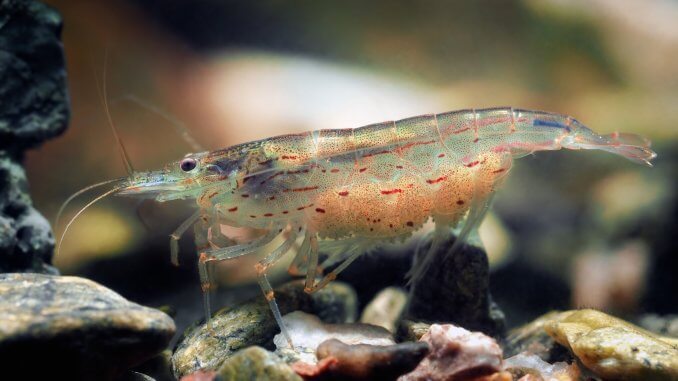
Welcome to one of the most popular Shrimps in the aquarium hobby.
For over a decade now Amano Shrimp have captivated hobbyists due to their exceptional ability to consume large amounts of algae.
In addition, their peaceful nature and busy-body personality have helped to sky-rocket its popularity over the last 15 years or so.
If you are considering Amano Shrimp this is the guide for you. We discuss how to care for them, ideal tank mates, dietary requirements, breeding and much more.
TABLE OF CONTENTS
Amano Shrimp Facts & Overview
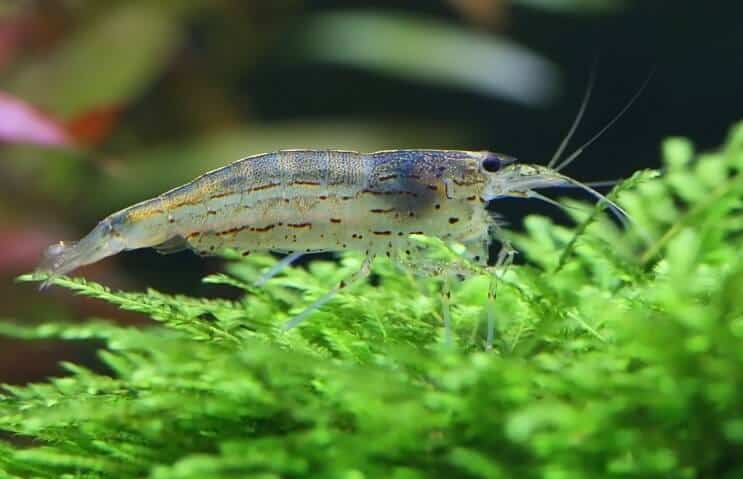
| Category | Rating |
| Care Level: | Easy |
| Temperament: | Peaceful |
| Color: | Transparent/greyish body |
| Lifespan: | 2-3 years |
| Size: | Up to 2 inches |
| Diet: | Omnivore |
| Family: | Atyidae |
| Minimum Tank Size: | 10 gallons |
| Tank Setup: | Freshwater, heavily planted |
| Compatibility: | Peaceful community fish, other shrimps, and snails |
The Amano Shrimp (Caridina multidentata) is known under a variety of names including:
- Caridina Japonica (previously named this until 2006)
- Japonica Shrimp
- Algae Eating Shrimp
- Yamato Shrimp
They were brought to popularity by Takashi Amano, because of their reputation for controlling algae and generally keeping tanks debris free.
Behind the cherry shrimp, it is the most popular freshwater Shrimp in the hobby
Interestingly, because they are incredibly hard to breed, the majority available to buy are actually wild Shrimp.
They are a hardy shrimp that makes it ideal for beginners looking to experiment with invertebrates for the first time.
They should be kept in at least a 10-gallon tank and can be kept in either a species only or community tank.
The tank should be heavily planted and contain lots of hiding places for them (more on that later).
Typical Behavior
In general, they are very peaceful; however, this all changes when the food comes out.
They will frantically race after the food and generally speaking the largest Shrimp has priority; you will definitely see a ‘pecking order’ here.
Outside of this, you will see them spend most of their time foraging amongst the substrate and plants for leftover shrimp food and debris to eat.
Whilst not exactly a behavior, another interesting observation is when they molt (this generally occurs each month).
When they are without a shell they feel vulnerable and normally go into hiding; this is why a heavily planted tank is a must.
Appearance
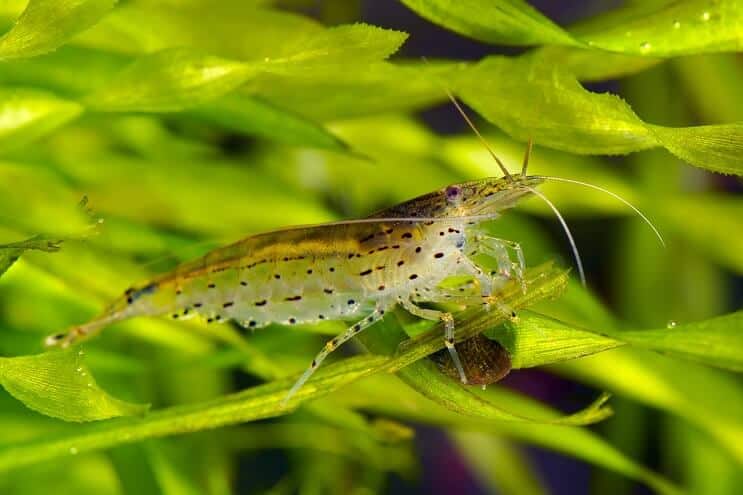 They are one of the larger “dwarf shrimp”, and can grow up to 2 inches. However, when buying them they will typically be less than 1 inch in length.
They are one of the larger “dwarf shrimp”, and can grow up to 2 inches. However, when buying them they will typically be less than 1 inch in length.
They are easily recognized by their large transparent/greyish colored body.
You will see a long line of red/brown or blue/grey dots running the length of their body; this is how you determine their sex (more on this later).
The coloring of these dots can vary significantly depending on their diet. A Shrimp heavily fed on algae and other greens will have a green tint to their dots.
You will also notice their tail (Uropod) is translucent
Finally, you will also notice that they can mask and blend into your tank incredibly well; they can be very difficult to find when hiding!
Top Tip: to find hidden shrimps shine a spotlight into the tank at night towards the substrate; the shrimp’s eyes will reflect and shine.
Sexing (Tell the Difference between Male and Female)
Unlike Cherry Shrimp, it’s actually very easy to identify the difference between male and female Amano Shrimp.
- Firstly, the females tend to be bigger than males.
- Secondly, you can look at the dots on their exoskeleton. The dots on females will be long dashes whereas for males they will be evenly spaced out dots.
- Finally, the females will have a saddle (i.e. egg nest) underneath her stomach where she stores her eggs.
Imposters and Lookalikes
Unfortunately within the aquarium trade, there are lots of imposters and lookalikes. Whilst many of these imposters look virtually identical you can tell the difference in their algae clearing ability.
There are more than 200 different varieties of Caridina, so you can easily see why much different Shrimp get confused as true Caridina multidentata.
The easiest way to identify imposters is because they are generally lazy don’t make good algae cleaners; real Amano Shrimp are relentless. Imposters tend to be smaller as well.
Finally, they will breed in freshwater aquariums whereas true Amano Shrimp require brackish water to breed.
Unfortunately, it is very difficult to visually identify imposters.
Habitat and Tank Conditions
True Amano Shrimp are native to Asia, specifically Japan, China and also Taiwan. They will live in large troupes within freshwater rivers and streams.
Fascinatingly though they don’t always live in freshwater. It’s only the adults that live in freshwater.
As larvae, they require brackish to hatch and survive. It’s only once they mature they will head to the freshwater rivers.
So how does all this translate to setting up your aquarium?
The first thing to note is that your tank should be thoroughly planned. This provides them with lots of shelters and gives them comfort.
You should be using plants such as Java Moss and Green Cabomba.
If you want to add even more hiding places for them you could consider Shrimp tubes. You can also add wooden branches into the tank.
Second, you should only add them to established tanks; debris and algae are crucial for them and this won’t be present in newly cycled tanks.
Finally, as for the substrate, you can use small rocks and pebbles to emulate the river beds of Japan.
Tank Conditions
They are reasonably hardy inverts and can withstand a wide range of water conditions;
- pH level: 6.0 – 7.0.
- Temperature: 70°F – 80°F.
- Water hardness: 6.0 – 8.0DKH.
In terms of currents; they are used to this because of their natural environment. A hang on back filter works best for them.
What Size Aquarium Do They Need?
They need to be kept in at least a 10-gallon aquarium. With an aquarium this size, you could keep at least 5 Shrimp in it.
How Many Amano Shrimp per Gallon?
As a good rule of thumb, you can add 1 Amano Shrimp per 2 Gallons. However, it obviously depends on the number, and species, of fish you have in the tank.
Tank Mates
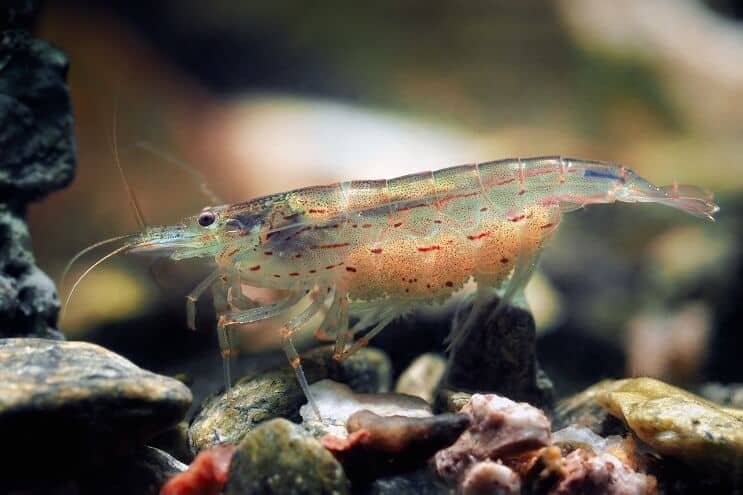 To start with it’s important to know that the Amano Shrimp is commonly viewed as food, so you should always exercise caution when adding them to a tank.
To start with it’s important to know that the Amano Shrimp is commonly viewed as food, so you should always exercise caution when adding them to a tank.
They are an incredibly peaceful species and have no real means to defend themselves.
You should be looking to include peaceful, small to mid-sized, community fish with your Shrimp. The following list of fish typically does well with them:
| Cherry Shrimp | Malaysian Snails | Guppies |
| Bamboo and Vampire Shrimp | Tiger Barb | Neon Tretras |
| Otocinclus Catfish | Discus | Mystery Snails |
| Cory Catfish | Bristlenose Pleco | Nerite Snails |
You should not keep your Shrimp with any large or aggressive fish. The following list will give you a good indication of which types of fish to avoid:
| Cichlids | Goldfish |
| Arowanas | Bettas |
| Oscars | Large Plecos |
| Crayfish | Gourami |
Remember if you are uncertain fall back on the old rule of thumb; “if it can fit in its mouth, then exercise caution”.
Keeping Amano Shrimp Together
If you plan on keeping Amano Shrimp it is recommended that you do not keep them alone. You should keep them in a group of at least 6 to help reduce any dominant behavior.
Also, try to maintain an even ratio of females and males.
They have such a small bioload that you don’t need to worry about overstocking the tank.
In addition to keeping them with their own species, you can also keep them with other peaceful Shrimp such as Cherry Shrimp and Ghost Shrimp.
Diet
If you didn’t already know, Amano Shrimp are famous for feeding on algae.
They are known as being one of the best cleanup crews in the hobby and will devour plant debris, leftover food, and algae. They have also been known to eat dead fish.
Unfortunately due to their reputation, many people believe that they only need algae and leftovers to survive, this is not true.
They will always need their diet supplementing. Obviously the more amounts of algae and debris in the tank for them to graze on, the less supplementing they will need.
They are actually omnivores, so will eat both meat and plant matter.
The core of their diet should consist of a high-quality pellet or algae wafer. However, you can also feed them on sinking pellets, frozen foods, and vegetables.
They will eat cucumber, squash, zucchini, and spinach to name a few.
Just remember though, the vegetables should be blanched and don’t leave them in the tank for longer than an hour because it will start to contaminate the water.
In terms of frozen snacks, think of the usual: bloodworms and brine shrimp.
Just like Cherry Shrimp, you should avoid placing anything with Copper into the tank; it is toxic to most invertebrates. Be sure to check the labels as many fish food and medication contains Copper.
Also, you should avoid placing them in a tank with black beard algae; they will not eat this.
Breeding
As previously discussed sexing them is fairly easy; however, attempting to breed them is anything but easy. They are incredibly difficult to mate and I’ve yet to hear from anyone that has successfully hatched the larvae and raised them into adults.
This is mainly due to the brackish water problem mentioned above (more on this later).
In the wild, the male will fertilize the eggs and the female will carry them for around six weeks. During this time, the female can often be seen wafting her tail to push oxygen over the eggs; similar to the Cherry Shrimp.
At the six week mark, she will release the larvae into brackish water. As larvae, they require salt water and as they mature and grow they need fresh water.
Remember adults should not be placed in brackish water; even a small exposure to salt can kill them.
It’s at this point you should remove the adults from the breeder tanks as you increase the salinity of the water.
Due to the limited success stories of breeding them, no more information could be found on breeding Amano Shrimp; this really is only an endeavor for the most experienced fish keepers.
If you are looking to breed Shrimp we would suggest you look at either Cherry or Ghost Shrimp.
Those very few success stories that we have heard of, breed these shrimp in full strength saltwater with a salinity level of around 1.024.
Care
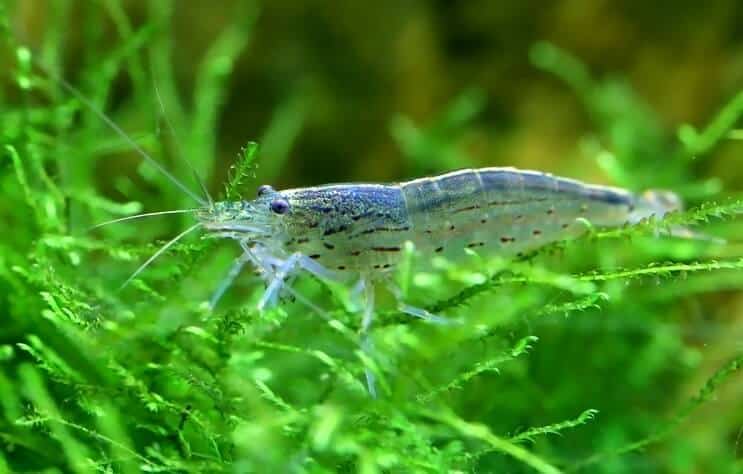 Amano Shrimp are one of the hardiest and least demanding inverts in the freshwater aquarium hobby.
Amano Shrimp are one of the hardiest and least demanding inverts in the freshwater aquarium hobby.
They can be kept both in a single species tank, or you can keep them with ghost or cherry shrimp.
Fortunately, because of their hardy nature, they don’t require much specialist care.
One of the biggest things you need to pay attention to is cooper. Avoid adding any copper into the tank as this is highly damaging to all invertebrate.
They are also surprisingly resilient to ammonia spikes; however if at all possible avoid rapid any pH or temperature drops.
You should pay special attention to them when they molt; this is when they are most vulnerable. You should expect them to shed monthly if they are well fed and feel secure.
Amano Shrimp Lifespan
When kept in an aquarium they should live between 2-3 years. They are most likely to die young as soon as they are added to a tank. So if they survive the first few weeks in your tank they should live a long life.
Is the Amano Shrimp Suitable for your Aquarium?
Now you know why Amano Shrimp are the most prized inverts within the aquarium hobby.
They are tireless workers, help keep your tank algae free and are also great community tank members as they are compatible with lots of peaceful fish.
In addition their resilient and hardy nature makes them perfect for people looking to try invertebrates in their tank for the first time.
After reading this guide you should now feel comfortable enough to know if Amano Shrimp are the right shrimp to put into your tank.
Do you have any questions about keeping Shrimp? Let us know in the comments section below

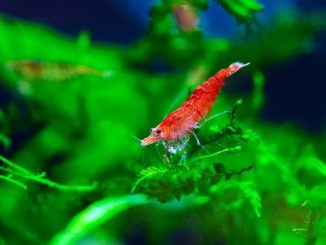
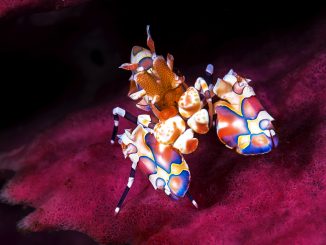
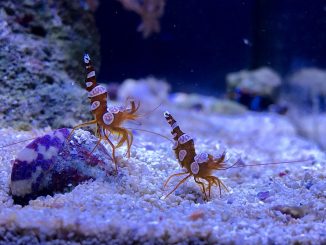
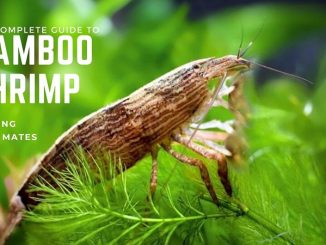
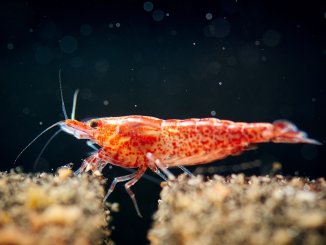
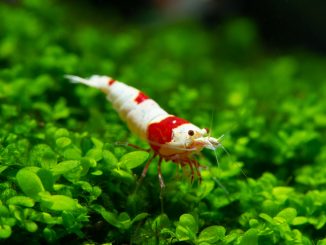
i have had 4 baby Ameno’s in 2 weeks and they are all still alive and well
Awesome! What did you do to breed/grow them? I want to try aswell.
They are probably not true amanos, they are probably imposters, they 100% need brackish water to survive otherwise they would be extremely cheap as breeding would be easy, there are over 200 species of shrimp in the same genus, you probably have another species of the same genus that look the same
Will they destroy aquarium plants or moss balls?
Hi Mohamad, they are omnivorous so it’s quite likely that they will nibble at your plants, however they typically prefer to eat dying plant matter and algae so I’d recommend housing them with plants without much issue. Thanks, Robert
Hello,
I have had a dozen amanos in my tank for well over six months. A couple of days ago something weird happened. Firstly, at least 8 of them started crowding around a small water circulation pump that I have in my tank. This included a couple of egg-laden females as well as the rest of my population.
The next day, I saw nine of them huddled together under an Amazon Broadsword plant leaf (or leaves) that were attached to bogwood. They all seemed perfectly contented on both occasions, but I had never seen this behaviour before.
The only difference that I can possibly put their behaviour down to is that I thoroughly cleaned the 3dm nuggets and 3dm beads that I have in my filter for the first time. My water changes are regular, but since the thorough cleansing of the media, I have noticed that the water is even cleaner and has less particulate matter in it than before. I use RO water with minerals, and change the filter wool and carbon every month.
Any ideas?
Cheers,
M.
Hi Martin, thanks for your question. I’m yet to see behaviour like this too so I’ll leave your question here in hope that someone else had had a similar experience which they can share with you. When you say you thoroughly cleaned the filter media, what did you use to clean it? They should only be cleaned in a bucket on your tank water to avoid stripped them of the good bacteria which has built up, and also to avoid introducing any chemicals to the tank. Thanks, Robert
It seems they get together when a female is ready to mate or when a female already has eggs and even when she is about to release the eggs. When it’s not mating time or breeding time or whatever, they seem to all go their separate ways. Sometimes at night they all run around in a circular fashion but don’t ever huddle together and stay still in one spot together unless it’s mating time or egg-release time. But that’s just my observation. I have 2 and 3 males. The largest female add released eggs and I did my best to help get them to adulthood. So far I have 8 small baby shrimp that are well on their way to adulthood. And right now that female is carrying eggs yet again! The other female did not keep her eggs but kicked them off after 2 maybe 3 weeks (unknown reason), the eggs hadn’t even changed colors yet. But periodically they all gather and get together and stay in one spot for a day or 2 before breaking up and going to separate corners.
My Amano (10 with at 6 males 4 females) occasionally congregate for a “meeting” I’ve seen it a few times. Idk why but it’s interesting and they seem perfectly happy. Both times (in 3 months of having them) was not around feeding time. Not around a filter cleaning of filter or tank. Once was when I turned on lights in the morning and the other in the afternoon after several hours of light. Other than size and cleaning ability what other ways can you distinguish true Amano from any other lookalike shrimp? Mine look like all the pictures and in the time I’ve had them they have grown large but idk about 2 inches. Maybe 1.5. Unsure if they are fully grown as none of my females have gotten berried yet. My Amano won’t touch any veggies I blanch or freeze. They will occasionally eat a pellet but are happy eating algae. They love the bubbler and love my mopani wood. A few will go off into plants and explore but most of the time they enjoy staying on the wood or around it. I have a heavily planted 10 gal with eco complete substrate.
Are their bio load actually that small? I have been keeping 3 Amanos in a tank with sand substrate and therefore their poop is visible. It looks like they poop just as much as Mystery snails.
After good results of amono shrimp in one tank. I added two to my second tank in early January which is heavily planted with Java and El Niño ferns. I was not sure that they survived until a month later when I saw one. It was the end of March when I discovered them both together. I usually see only one at a time about once a week but I can tell they are thriving.
How long can these things really live? I’ve had some for 8 years now. 2 years in a 20g then 6 in a 55g. It’s a heavily planted tank, they have plenty to eat and there is only guppies in the tank but 8 years is crazy. Originally had 6, only am sure of seeing 3 now. I’m positive they are amanos.
Hi James, they usually like for around 3 years, so 8 years is very good going! Thanks, Robert
hi just reading about life span, I’ve had 3 Amano survive in my 180litre heavily planted tank with various tetras and cherry shrimp for probably five years, I lost two in probably the first weeks and I am glad to hear that the life expectancy is not as short, when asking in aquarists shops and being told they don’t last long I get the oh you must be lucky response.
I have also had my Amanos for longer than the advertised 3 years, maybe 5 years, possibly more. I am happy to hear that someone else has experienced this as well, as I thought I was crazy! I have a 55 gallon well-established planted tank that they share with some danios, a black skirt, neons, corys and cherry shrimp.
Hi,
We have an Amano shrimp which is around 12 years old now.
I found this page after googling to see how long they are supposed to live, so you can imagine how shocked I am that they should only live for around 3 years.
I bought my amano shrimps “The 3 Amigos” in 2011 and they are still going strong today. ?
Hi there I had a quick question. Is Copper Sulfate any safe for the Amano Shrimp? I was feeding them some leftover Aqueon tropical flakes that had them but they survived that for some reason. I was just checking to make sure nothing happens to them in the future. Thanks
Hi Chase, copper sulfate is deadly to most invertebrates so I’d switch their food. Thanks, Robert
Oh thank you so much! I also had another question that might be off topic. I heavily planted my aquarium and my shrimp just love it but I’m kind of worried about something. Some of the plants in my aquarium are actually a different species and getting brown spots/yellowish fading leaves and I’m just wondering if all plants no matter species need the same lighting or is it because it’s a different plant with different care? I keep my lighting on for 8 hours. Thanks.
Hi Chase,
Different plants require different strengths of lighting, but I usually recommend to go for a mid-range lighting if you’re keeping multiple species.
How long has your tank been set up for? Some plants can take a couple of months to readjust to your water. Remove any dead leaves or leaves with brown spots and give them a couple of weeks to see if they recover. If not, you’ll likely want to use supplements.
Thanks, Robert
My tank has been set up last October of what I remember so it’s been 6-7 months but I don’t know what day, sorry. I use seachem flourish excel and seachem flourish as my supplements do my plants need them?
Beware of using Seachem excel- it’s a toxic chemical and many testimonials point to harm to fish and invertebrates as well toxicity to mosses and floating plants. Most plants don’t need excel and setting up co2 for those that do need it is pretty easy. You can start Co2 for around $20
I am thinking about getting a Amano Shrimp and I have a 10 gal tank. I currently have 2 glofish and they have been there for about a year. The main thing I wanted to ask is if I can have some large fake plants instead of real ones. There is still some algae on the fake plants I have now. This is mainly because a real plant can be a lot of hard work. Please get back to me soon, I might get one or two today.
Hi Gavin, thanks for your message. Yes, fake plants are fine, just make sure you feed your shrimp algae wafers instead. Thanks, Robert
I’ve two males and three females, of which are always carrying eggs. I moved them yesterday (as I had to treat my main tank) to my 60L cherry shrimp tank, of which has very similar water parameters. A few hours ago I couldn’t believe my eyes when I noticed that one of the females has hatched her eggs, got to be at least 1,000 babies. Off to LFS tomorrow for advice, but for now I’ve turned filtration off to stop them getting sucked up, fingers crossed the other shrimp don’t eat them!
Have you noticed any decrease since then? I’ve only had hatches in my Anono shrimp when moved to a vase of similar fresh water. When hatched Ive had luck for a good 24 days, so far, with a water peramiter of 32ppm salinity (every other day I’ll switch from fresh water to saline water to compromise for evaporation with a small inverted water bottle ) Plan to switch them at 45 days to just freshwater with a improvised drip system. Or until they start swimming sporadically. Amono shrimp go through metamorphosis like butterfly and are not born true shrimp looking creatures, once sportatic swimming is observed, the shrimps are presumably looking for freshwater and should be drip acclimated thenforth.
Have you successfully reared the shrimp to maturity (i.e. back into fully fresh water)?
@ Yup how did you get on with your amano zoes ?
I have an Amano shrimp that I have had in my aquarium for 12 years. I feel like the expected life span is due to aquarium conditions and not the natural life span of the species. It is a male shrimp.
I’m interested in your tank size, population, and how you have cared for it-water type, changes, etc… have you had vacations and what do you feed your tank mates and Amani shrimp. I want so bad to keep all mine alive. At least as many as I can. Thanks so much.
im currently about to put a few hundred amano zoes into 2 seperate tanks, 1 with RO water and the other with normal aquarium water, both tanks salted to 33ppt and heated to 24C, feeding them phyto fusion , mix of 4 diff types of algae from 1-150 microns. once tanks is cycled the other isnt, be interesting to see the outcome of both. 2 females i had in a heated and aerated plastic bucket have released, theres still one that hasnt this will be night 2 for her, hopefully she will release and i can get on with this project.
Day 7 and theyre dong well
Hi Vince how are they doing
Wow…mine have so many eggs I don’t know what to do
hi there.i have some amano’s in my brackish puffer fish tank for about 3 months now in a sg of .015 they are still surviving , i can see them at night when i turn the flash light on the aquarium . they were supposed to be food , but they seem to do well . they look very smart compared to sherry shrimps the puffers can’t catch them easily !
My long established 30 gallon tank has suddenly exploded with long filaments of algae – in the past I’ve only had slime-type covering the glass at times – which I clean off rubbing with a bit of filter floss. I am open to getting some Amano shrimp but concerned about tank mates, specifically the 4 Clown Loaches I have. Other fish are 1 each Angel and long-finned Danio and 5 Cory Cats. The Clown Loaches were bought to control pond snails; and they did a superb job of that. Can anyone advise the compatibility of Amano shrimp with Clown Loaches?
Yes, clown loaches love invertebrates such as shrimp. Shrimp don’t go well with loaches in general. Your angel fish, danio and cory cats won’t bother them.
Last year an amano gave birth then her body started to get rigid and she turned a dullish looking white color. Within a couple of days she died. I now have another amano doing the same thing though if she had babies I’m pretty sure my black loaches took care of them. I can’t find anywhere why this is occurring and it looks as if it is painful since the process starts from the tail and travels up the body.
We’re new to owning fish, have a 40 litre tank with 8 small fish in (danios & platys) & would like to add some Amanos. After reading this I think they’d be ok but will probably only have room for 4. But we’re having an issue with brown algae & are wondering if the Amano will eat it as we’d rather go for a more natural solution instead of using additives if we can. Would this be ok in our tank?
I have been successful one time breeding and raising the tiny plankton size shrimp lets. I am attempting to repeat my success currently. This is how I was successful.
From the time the shrimp hatch they are free floating plankton size for about 30 days. That is if you get them into the salt water within 48 hours of hatching. My method for removing them from a ten gallon set up was with a plastic pipette. They can immediately go into the salt tank. You will be able to just barely see them floating as tiny white comma shaped specks. The tank set up you move them to should have a salt water salinity of 32-35ppt. Be sure to have an air stone to keep the water flowing. About every other day you will need to feed them about 10 drops of Seachem Reef Phytoplankton and or “green” water (algae water). On the 15th day you will need to carefully do a water change and the replacement water should still be within the 32-35ppt salinity. Continue feeding them every other day. Once 30 days hits they should start their morph into the adult form and at that point carefully syphon them out into a cup that is filled with 2/3rds your salt water and a 1/3 fresh water. The next day put them into a cup that is ½ salt and ½ fresh water. On the third day 1/3rd salt and 2/3rds fresh. This is to simulate their natural environment of swimming upstream into their new habitat. On the 4th day they can finally be released into your grow fresh water aquarium. They will still be quite small so at this point you can feed them vegetables like zucchini or peas and any shrimp food you feed your adults with.
I hope this information helps and encourages people to try. It is very rewarding!
I have a shrimp that is now coming up to 7 years old. We wanted to run the fish tank down, and have been left with one solitary shrimp for 4 years now. Anyway, the other day it had a huge thing coming out of him. It was huge compared to the size of the shrimp. I can only describe it as looking like a tic that you would see on an outdoor animal. It seemed to be partly inside of the shrimp, and he eventually looked like he pulled it out. It went to the top of the water and it looked like it had spindly but coming off it. Does anyone have any ideas as to what it might have been?
I have 5 amano’s in with my blue dream shrimp. When I got home I noticed the amano’s bouncing around which was a little strange. I kept watching to see what could be wrong and noticed one with eggs. I know they need brackish water to survive. This had become a challenge.
Hello, The section on diet saying they will not eat Blackbeard Algae is not true. They are eating that like crazy in my tank.
One of my amano shrimp has been carrying eggs since July. We have four shrimp in a 29-gallon tank kept at 78F with a few fish and snails; they have been together since March. The eggs have changed color a number of times in the last five months. Are they rotting? Any idea on what to expect?
Big thanks for the info on the aminos! I have 5 Loaches in a heavily planted 30 gallon tank with loads of hiding places. I hardly ever see the Loaches. I wonder if the Loaches and Aminos won’t bother each other sharing hiding places? Next to the 5 Loaches I have a couple of ottocinclus and one dragon crown tail betta, that is truly is the king of the aquarium. Not aggressive tho, just super curious. I wonder how well the aminos would do in my tank?
Sorry for the typo! Amano shrimp ofc!